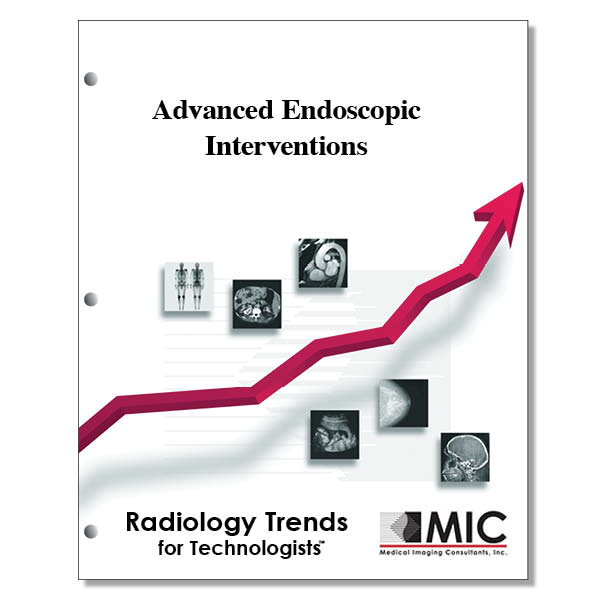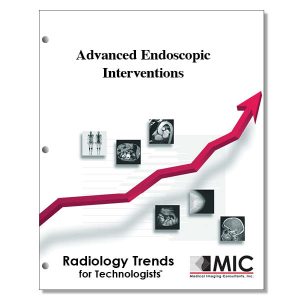

Advanced Endoscopic Interventions
Indications and advantages of the expanding roles of endoscopic techniques are presented. Imaging appearance, post-operative anatomy, and potential complications are described.
Course ID: Q00709 Category: Radiology Trends for Technologists Modalities: CT, Radiography, Vascular Interventional2.75 |
Satisfaction Guarantee |
$29.00
- Targeted CE
- Outline
- Objectives
Targeted CE per ARRT’s Discipline, Category, and Subcategory classification:
[Note: Discipline-specific Targeted CE credits may be less than the total Category A credits approved for this course.]
Computed Tomography: 1.00
Procedures: 1.00
Abdomen and Pelvis: 1.00
Radiography: 1.50
Procedures: 1.50
Thorax and Abdomen Procedures: 1.50
Registered Radiologist Assistant: 1.50
Procedures: 1.50
Abdominal Section: 1.50
Vascular-Interventional Radiography: 1.50
Procedures: 1.50
Nonvascular Procedures: 1.50
Outline
- Introduction
- Peroral Endoscopic Myotomy
- Indications and Preliminary Workup
- Endoscopic Technique
- Expected Postoperative Appearance
- Advantages and Complications
- Endoscopic Submucosal Dissection
- Indications and Preoperative Imaging
- Technique
- Expected Postoperative Appearance
- Advantages and Complications
- Endoscopic Bariatric Therapy
- Indications, Advantages and Preliminary Workup
- Endoscopic Technique
- Expected Postoperative Appearance
- Complications
- EUS-Guided Drainage through LAMS and Covered Metal Stents
- Overview and Preoperative Imaging
- Endoscopic Techniques and Indications
- EUS-Guided Biliary Drainage
- EUS-Guided Drainage of the Gallbladder and Abscesses
- EUS-Directed Gastrojejunostomy
- Expected Postoperative Appearance
- Advantages and Complications
- Conclusion
Objectives
Upon completion of this course, students will:
- list the advantages of an endoluminal approach
- outline the radiologist’s role as intraluminal procedures become more common
- define achalasia
- choose the number of subtypes of achalasia
- list the symptoms of achalasia
- state the number of individuals affected by achalasia each year
- list the preoperative achalasia testing requirements
- list clinical findings suggestive of pseudoachalasia
- differentiate between long and short-term treatments for achalasia
- recall the success rate for laparoscopic Heller myotomy in the treatment of achalasia
- describe the post-procedural appearance of Heller myotomy
- choose the correct lumen size for best success in POEM procedures
- list common POEM postprocedural findings
- choose the percent of POEM patients that develop intraluminal dissection
- state the clinical success rate of POEM
- list benefits of POEM over laparoscopic Heller myotomy
- state the percent of patients that experience persistent achalasia after unsuccessful POEM
- list the areas of the body where the traditional treatment of early gastrointestinal tumors has been surgery
- discern what patient population is eligible for the gastric endoscopic submucosal dissection procedure
- list tumor aspects that are delineated at preoperative imaging for endoscopic submucosal dissection
- list the classification systems for gastroesophageal tumors
- list surgical methods for the treatment of gastroesophageal tumors
- outline the advantages of endoscopic submucosal dissection as compared to surgery
- list the complications associated with endoscopic submucosal dissection
- know which imaging modality is used to assess endoscopic submucosal dissection patients for pneumoperitoneum, leakage of oral contrast material, and fluid collections
- state how many people worldwide are affected by obesity
- explain how bariatric surgery is effective
- give the percentage of eligible patients that actually undergo bariatric surgery
- state the body mass index required for endoscopic bariatric therapy
- list the most common techniques for endoscopic bariatric therapy in the United States
- explain the need for endoscopy prior to placement of an intragastric balloon
- explain the goal of placement of an intragastric balloon
- state the duration of endoscopically placed intragastric balloons
- recall the spontaneous deflation rate for intragastric balloons
- list the contraindications to intragastric balloons
- state the goals of endoscopic sleeve gastroplasty
- choose the imaging modality used to identify and locate the intragastric balloon and radiopaque valve
- list the common adverse events of intragastric balloons
- list the expanded use of covered metal stents and lumen apposing metal stents
- state the shape of lumen apposing metal stents
- choose the imaging procedure that confirmed stent placement following endoscopic ultrasound guided biliary drainage
- state the common and expected finding following endoscopic ultrasound directed gastrojejunostomy
- state adverse events that can result from endoscopic ultrasound guided drainage procedures
